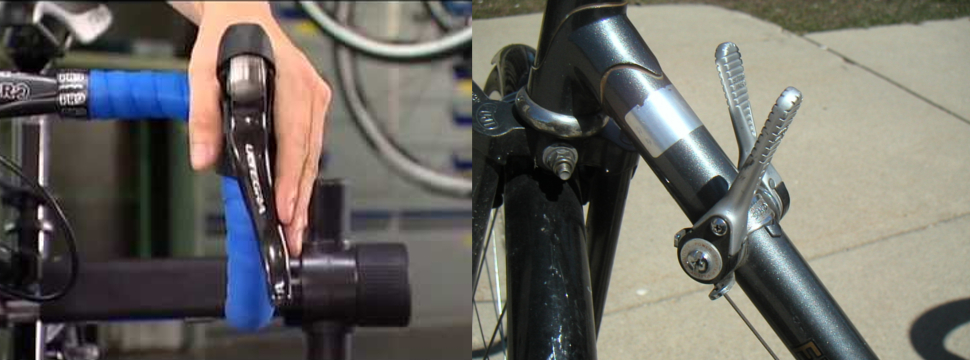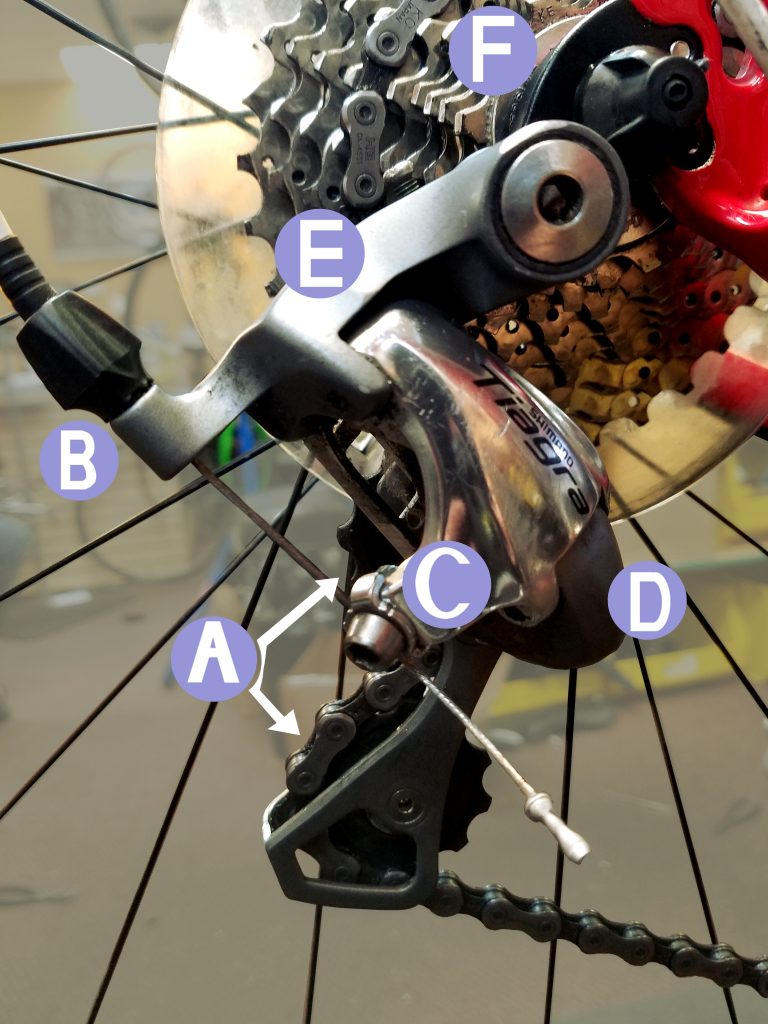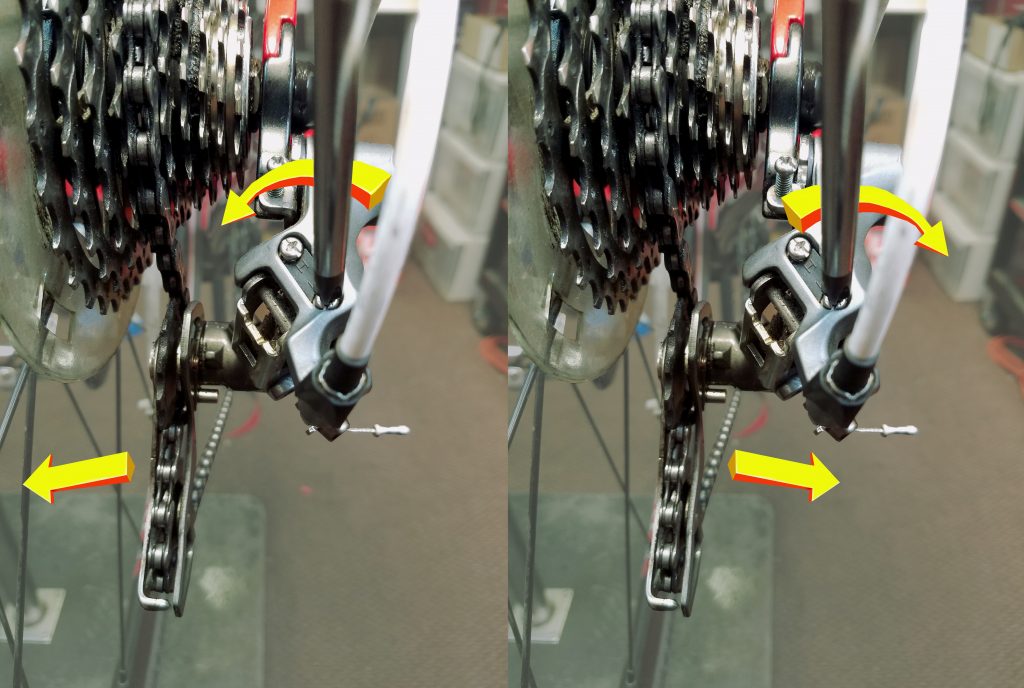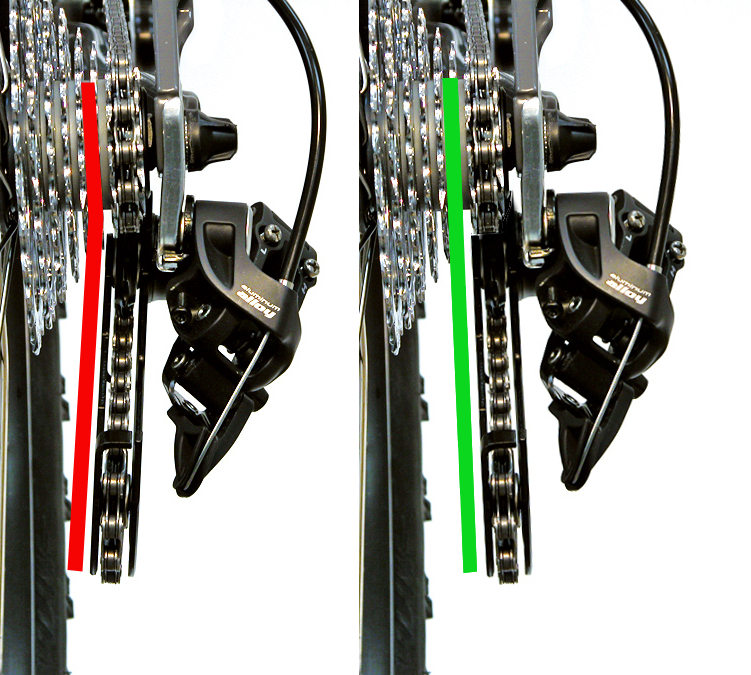by John Brown, HaveFunBiking.com
It goes by many names, the rear derailleur. It is also known as the “s,” the “hangdown,” or the mech. Here in the U.S. we refer to it as the rear derailleur. The device that moves your bike’s chain from gear to gear letting you traverse hills with ease. Even though derailleurs are sturdy and relatively maintenance free, they do require attention occasionally. Look below for the step by step instructions on how to adjust your bike’s rear derailleur.
Rear Derailleur Terminology
Twist shifter – A shifting device that rotates around the handlebar like the throttle of a motorcycle.
Trigger shifter – A Shifter that activates by pushing or pulling a set of paddles with your thumb and index finger.

STI shifters – Technical this stands for Shimano Total Integration and speaks directly about one brands type of road bike shifter, but it has become the generic term for any drop bar shifter/brake lever combo.
Thumb shifter – A shifter that can be mounted in many places like; the stem, bar end, brake lever, or top of the bar. These shifters are the most rudimentary type of shifter, and operate by simply actuating a lever with your thumb.

Derailleur parts
(A) Jockey Wheels- two small wheels on the derailleur on which the chain run. They are mounted onto the derailleur cage
Limit screws- The limit screws control the area of motion a derailleur has. On most derailleurs there are three limit screws: the upper limit, Lower limit, and B-limit. The upper limit screw sets the maximum distance the derailleur can shift in high gears. The lower limit screw sets the maximum distance the derailleur can shift in the lower gears. The B-limit screw sets the distance the upper jockey wheel sits from the cogs.
(B) Barrell adjuster – This is an adjustment device on the back of most derailleurs. It is the area where the derailleur cable enters the derailleur and can increase or decrease the cable tension by threading it in and out.
(C) Pinch bolt – The pinch bolt is where the derailleur cable gest secured.
(F) Derailleur hanger – The portion of the bike frame where the rear derailleur is mounted.

Is everything straight?
The cogs your rear derailleur shifts across can have as little as 2.14 millemeters of spacing between them. Considering the spacing is so narrow, look to see that everything is aligned properly before you start adjusting your rear derailleur in vain. Look first at the derailleur itself from behind. You should be able to see if the derailleur itself is aligned properly. A tell-tale sign of damage is when the two Jockey wheels don’t line up with the cogs or each other (see picture).

Next assure that the derailleur hanger is aligned properly. This is easily seen when the derailleur appears straight, but not in line with the cogs. Consequently, if either the derailleur or derailleur hanger are bent, it’s best to take it into your local shop for a remedy.
Step 2, A man has got to know his limitations
Before attempting to adjust the derailleur properly, set its usable range. First, loosen the pinch bolt and let the derailleur run on the smallest cog. Next, pedal forward while visually and audibly inspecting how the chain runs on the smallest cog. The chain should run smoothly without any clicking, or skipping noises. If it runs smoothly, don’t worry about the upper limit. when you do experience skipping or noise, look closely at how the chain runs on the cog (looking from behind is easiest). If the chain isn’t coming directly off the upper jockey wheel and going straight onto the small cog you need to adjust the upper limit. By threading the limit in or out you can adjust where the derailleur sits in relation to that smallest cog (note: the limit screws don’t need to get “tightened” down, they simply act as a stop for the derailleur).

Once the upper limit is set, pedal forward and push on the derailleur lower knuckle until it moves the chain into the largest cog. If the chain has issue getting into the largest cog, or jumps over that cog into the wheel spokes, you need to adjust the lower limit screw in a similar fashion to the upper limit screw.
Rear Derailleur Tension
With the limits set, you can now move on to tightening the cable and trying to shift. Make sure the shifter is in its lowest gear by shifting down while gently pulling on the shift cable. With the shifter in its lowest position, ensure all housing ends are settled into the frame properly then pull the cable taught through the derailleur. With the cable taught, tighten the derailleur pinch bolt onto the cable. Trim any excess cable so that only about one inch of cable extends beyond the pinch bolt and crimp it off as not to fray.
While pedaling, shift one gear up. Ideally, the chain will easily move from the smallest cog up to the next cog. It should stay on the second cog and run quietly and smoothly. If it hesitates to get to the second cog, increase cable tension by rotating the barrel adjuster out. If you cannot increase tension enough with 3 or 4 turns of the barrel adjuster, thread it back in, loosen the cable pinch bolt, pull the cable taught, and tighten the pinch bolt again. Once you have the chain shifting up the cogs easily, check to see if it will smoothly move back down the cog stack by shifting from the largest cog down and inspecting. The only difference is in the adjustment. If the chain hesitates to move down the gears, turn the barrel adjuster in (relieving cable tension).

Rear Derailleur Trouble shooting
What happens if you can get the chain to move up the cogset well, but can’t get it to move back down the cogset easily. In some cases, the cable and housing can be corroded and causing drag. This drag won’t affect the shifting moving up the gear set, but it will stop the derailleur from returning. In tis case, you can clean and lube the cables and housing, or just replace the cable and housing all together.
Additionally, there may be a grinding/banging noise in only the largest cog. That noise is caused by the upper jockey wheel running on the largest cog. To remedy this, tighten the b-limit screw until the noise subsides.
Finally, a common problem is if you get skipping while pedaling up steep grades or under load. If your derailleur is adjusted properly, and you’re getting skipping, it may be related to a worn out drivetrain. As your chain ages, it stretches slightly. As the chain stretches, the front face of the gears will wear in unison with the chain stretching. Once the chain stretches beyond the point where it will mesh with the gears, you will experience skipping under load.
Working on your own bike is fun. Also, your appreciation for the technology and engineering that goes into what is considered a simple machine will grow with each turn of the wrench. Periodically, you will run into a problem you cannot solve. If that is the case, bring your bike to your local shop, talk honestly with the mechanic about what you tried and what you are trying to accomplish. As a result, you will find that most mechanics will be happy to teach you what you need to know.




Comments
4 responses to “Tips and Tricks to Adjust Your Bike’s Rear Derailleur”
This rear derailleur adjustment article was great! It copied and pasted into a Word document so I can print the text & photos and have it on the bench as a reminder when running through the adjustments on a bike. Good Job!!
Thanks Dean! we appreciate the kind words.
Wow this works. And my specialty is destroying bikes not working on them.
Cool! I’m glad to hear we could help save one more bike out there. Check out our other articles on adjusting brakes, wheels, front derailleurs, and even your fit!